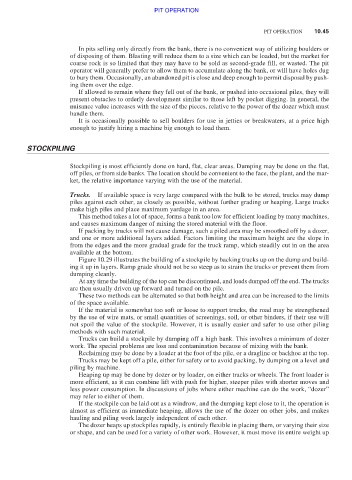Page 539 - Moving the Earth_ The Workbook of Excavation
P. 539
PIT OPERATION
PIT OPERATION 10.45
In pits selling only directly from the bank, there is no convenient way of utilizing boulders or
of disposing of them. Blasting will reduce them to a size which can be loaded, but the market for
coarse rock is so limited that they may have to be sold as second-grade fill, or wasted. The pit
operator will generally prefer to allow them to accumulate along the bank, or will have holes dug
to bury them. Occasionally, an abandoned pit is close and deep enough to permit disposal by push-
ing them over the edge.
If allowed to remain where they fell out of the bank, or pushed into occasional piles, they will
present obstacles to orderly development similar to those left by pocket digging. In general, the
nuisance value increases with the size of the pieces, relative to the power of the dozer which must
handle them.
It is occasionally possible to sell boulders for use in jetties or breakwaters, at a price high
enough to justify hiring a machine big enough to load them.
STOCKPILING
Stockpiling is most efficiently done on hard, flat, clear areas. Dumping may be done on the flat,
off piles, or from side banks. The location should be convenient to the face, the plant, and the mar-
ket, the relative importance varying with the use of the material.
Trucks. If available space is very large compared with the bulk to be stored, trucks may dump
piles against each other, as closely as possible, without further grading or heaping. Large trucks
make high piles and place maximum yardage in an area.
This method takes a lot of space, forms a bank too low for efficient loading by many machines,
and causes maximum danger of mixing the stored material with the floor.
If packing by trucks will not cause damage, such a piled area may be smoothed off by a dozer,
and one or more additional layers added. Factors limiting the maximum height are the slope in
from the edges and the more gradual grade for the truck ramp, which steadily cut in on the area
available at the bottom.
Figure 10.29 illustrates the building of a stockpile by backing trucks up on the dump and build-
ing it up in layers. Ramp grade should not be so steep as to strain the trucks or prevent them from
dumping cleanly.
At any time the building of the top can be discontinued, and loads dumped off the end. The trucks
are then usually driven up forward and turned on the pile.
These two methods can be alternated so that both height and area can be increased to the limits
of the space available.
If the material is somewhat too soft or loose to support trucks, the road may be strengthened
by the use of wire mats, or small quantities of screenings, soil, or other binders, if their use will
not spoil the value of the stockpile. However, it is usually easier and safer to use other piling
methods with such material.
Trucks can build a stockpile by dumping off a high bank. This involves a minimum of dozer
work. The special problems are loss and contamination because of mixing with the bank.
Reclaiming may be done by a loader at the foot of the pile, or a dragline or backhoe at the top.
Trucks may be kept off a pile, either for safety or to avoid packing, by dumping on a level and
piling by machine.
Heaping up may be done by dozer or by loader, on either tracks or wheels. The front loader is
more efficient, as it can combine lift with push for higher, steeper piles with shorter moves and
less power consumption. In discussions of jobs where either machine can do the work, “dozer”
may refer to either of them.
If the stockpile can be laid out as a windrow, and the dumping kept close to it, the operation is
almost as efficient as immediate heaping, allows the use of the dozer on other jobs, and makes
hauling and piling work largely independent of each other.
The dozer heaps up stockpiles rapidly, is entirely flexible in placing them, or varying their size
or shape, and can be used for a variety of other work. However, it must move its entire weight up

